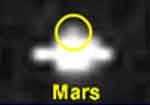DS1 is a New Millennium technology-validation mission that will fly by Asteroid 3352 McAuliffe and Comet P/West-Kohoutek-Ikemura. It is scheduled for launch on July 1, 1998. The two principal instruments on the mission are a Miniature Integrated Camera and Spectrometer (MICAS), provided by the Jet Propulsion Laboratory (JPL), and a Plasma Experiment for Planetary Exploration (PEPE), provided by the Southwest Research Institute (SwRI) and the Los Alamos National Laboratory (LANL). EDITOR: Anybody get the feeling that these Alamos inspired buckaroos blew something up? That is what they seem to do best, yeeeehawww! DS1's mission was to test these important, high-risk technologies in order to reduce the cost and risk of future science missions. EMAIL: 98-04-19 09:22:13 EDT : Remember the ship we lost about 2 years ago, as it arrived in Mars orbit it just disappeared?...it was a nuke. It exploded 1500 feet above surface Blowing up worlds 2 3 debate and challenge TWO NEW ELEMENTS were discovered: They were called "COSMIUM" (as it, being the "end-of line" element. discharged "Cosmic Particles", (that also disintegrated everything in their path) and the next EOL was one named ISOLIUM. Nuking Worlds? Air Force planned to nuke the moon.
Review of Target Comets for Space Missions The seven targets chosen for the missions are 76P/West-Kohoutek-Ikemura (DS1), 81P/Wild 2 (Stardust), 2P/Encke, 6P/d'Arrest, 73P/Schwassmann-Wachmann 3 (CONTOUR), 46P/Wirtanen (ROSETTA), and 9P/Tempel 1 (DS4). |
But engineers saw a hope for rejuvenating the distant craft to allow it to continue its solar system journey. By redesigning it with new computer programs, the team has developed a method to have the camera replace the star tracker. The DS1 science team met in January and concluded that the originally planned target should be kept. Although the primary mission concluded last year, one of the most important events of the mission took place this month. Over 100 engineers and scientists from NASA as well as other government agencies, private industry, and academia gathered to discuss the results of the testing of DS1's payload of 12 technologies. As the hundreds of trillions of devoted readers know, DS1's mission was to test these important, high-risk technologies in order to reduce the cost and risk of future science missions. Among the information returned were infrared observations DS1 made of the planet Mars in November. The results of scientists' analyses of those data will be described in the next status report. DSI MOVIE: pretty fancy propulsion system. eh? SOLAR ELECTRIC (ION) PROPULSION 76P: Matrix Theory Matric Mechanics NSA Super Spook takes over Mars missions RECENT SPIN: The Incredible Ions of Space Transportation
|
||||||||||||
